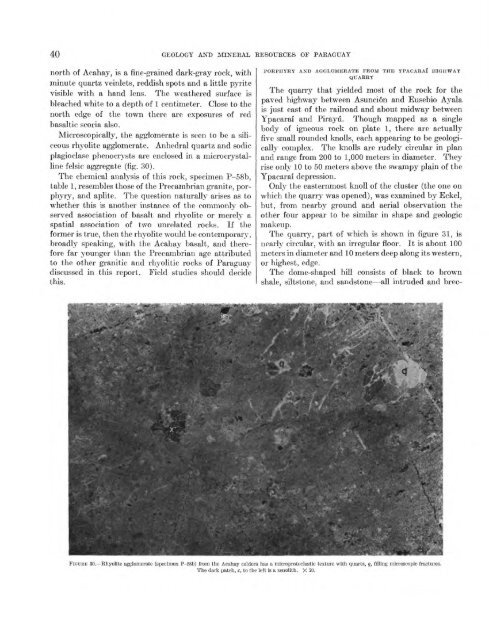Geology and Mineral Resources of Paraguay A Reconnaissance
Geology and Mineral Resources of Paraguay A Reconnaissance
Geology and Mineral Resources of Paraguay A Reconnaissance
- No tags were found...
Create successful ePaper yourself
Turn your PDF publications into a flip-book with our unique Google optimized e-Paper software.
40 GEOLOGY AND MINERAL RESOURCES OF PARAGUAYnorth <strong>of</strong> Acahay, is a fine-grained dark-gray rock, withminute quartz veinlets, reddish spots <strong>and</strong> a little pyritevisible with a h<strong>and</strong> lens. The weathered surface isbleached white to a depth <strong>of</strong> 1 centimeter. Close to thenorth edge <strong>of</strong> the town there are exposures <strong>of</strong> redbasaltic scoria also.Microscopically, the agglomerate is seen to be a siliceousrhyolite agglomerate. Anhedral quartz <strong>and</strong> sodicplagioclase phenocrysts are enclosed in a micro crystallinefelsic aggregate (fig. 30).The chemical analysis <strong>of</strong> this rock, specimen P-58b,table 1, resembles those <strong>of</strong> the Precambrian granite, porphyry,<strong>and</strong> aplite. The question naturally arises as towhether this is another instance <strong>of</strong> the commonly observedassociation <strong>of</strong> basalt <strong>and</strong> rhyolite or merely aspatial association <strong>of</strong> two unrelated rocks. If theformer is true, then the rhyolite would be contemporary,broadly speaking, with the Acahay basalt, <strong>and</strong> thereforefar younger than the Precambrian age attributedto the other granitic <strong>and</strong> rhyolitic rocks <strong>of</strong> <strong>Paraguay</strong>discussed in this report. Field studies should decidethis.PORPHYRY AND AGGLOMERATE FROM THE YPACARAI HIGHWAYQUARRYThe quarry that yielded most <strong>of</strong> the rock for thepaved highway between Asuncion <strong>and</strong> Eusebio Ayalais just east <strong>of</strong> the railroad <strong>and</strong> about midway betweenYpacarai <strong>and</strong> Pirayu. Though mapped as a singlebody <strong>of</strong> igneous rock on plate 1, there are actuallyfive small rounded knolls, each appearing to be geologicallycomplex. The knolls are rudely circular in plan<strong>and</strong> range from 200 to 1,000 meters in diameter. Theyrise only 10 to 50 meters above the swampy plain <strong>of</strong> theYpacarai depression.Only the easternmost knoll <strong>of</strong> the cluster (the one onwhich the quarry was opened), was examined by Eckel,but, from nearby ground <strong>and</strong> aerial observation theother four appear to be similar in shape <strong>and</strong> geologicmakeup.The quarry, part <strong>of</strong> which is shown in figure 31, isnearly circular, with an irregular floor. It is about 100meters in diameter <strong>and</strong> 10 meters deep along its western,or highest, edge.The dome-shaped hill consists <strong>of</strong> black to brownshale, siltstone, <strong>and</strong> s<strong>and</strong>stone all intruded <strong>and</strong> brec-FIGUEE 30. Rhyolite agglomerate (specimen P-58b) from the Acahay caldera has a microprotoclastic texture with quartz, q, filling microscopic fractures.The dark patch, x, to the left is a xenolith. X 20.
















